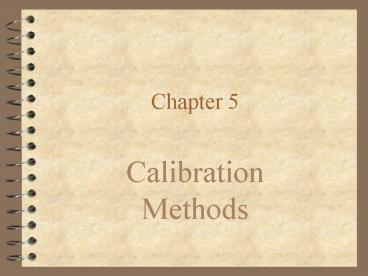Calibration Methods PowerPoint PPT Presentation
1 / 19
Title: Calibration Methods
1
Chapter 5
- Calibration Methods
2
Calibration Methods
- Calibration Curve
- Standard Addition
- Internal Standards
3
Calibration Curve
- Graphs the instrumental response to
- Standard Solutions
- Analyte solutions of known concentrations
- Blank Solution
- Solution that contains all reagents and solvents
except the analyte - Negates effects caused by impurities and
interfering species
4
Calibration Curve Construction and Use
- Prepare the standard solutions
- Varying concentrations of analyte
- Ideally incorporates the concentration of unknown
- Collect data for each of the standards
- 3 or more recommended
- discovery of inconsistent measurements
- Calculate the Corrected Absorbance value for each
standard concentration - Corrected Absorbance standard solutions average
absorbance - blank solutions average absorbance
5
Calibration Curve Construction and Use
- Plot a graph of corrected absorbance values
versus analyte concentration - Obtain Calibration Curve
- Method of Least Squares
- Determinants
6
Obtain Calibration Curve
- Method of Least Squares
- di2 (yi - y)2 (yi - mxi -b)2
- Determinants
7
Calibration Curve Construction and Use
- Find the Uncertainties associated with the slope,
y-intercept, and y (corrected absorbance) - d(bar) - 0 for best straight line
- 2 degrees of freedom are lost in determination of
slope and y-intercept
8
Calibration Curve Construction and Use
- Find the Uncertainties associated with the slope,
y-intercept, and y (corrected absorbance)
9
Calibration Curve Construction and Use
- Calculate the Uncertainty associated with the
x-value - Analyze the unknown
10
Calibration Curve Example
Amount of Protein (?g)
Absorbance of Independent Samples
Range
Corrected Absorbance
m 0.01630 sm 0.00022 sy 0.0059
b 0.0047 sb 0.0026
11
Standard Addition Method
- Unknown concentrations of analyte are determined
via deduction obtained from the calibration curve
resulting from adding quantities of known
standards to unknown concentrations of analyte. - Important when the sample composition is unknown
or complex
12
Standard Addition Curve Construction and Use
- Procedure 1
- Prepare samples to be analyzed
- Add the same quantity of unknown to each of
several volumetric flasks - Add varying quantities of known standard to all
but one of the volumetric flasks - Dilute all volumetric flasks to their mark
13
Standard Addition Curve Construction and Use
- Analyze the samples
- Construct a graph using the data obtained
14
Standard Addition Curve Construction and Use
- Construct a graph using the data obtained
- x-intercept of the extrapolated line is the
concentration of the unknown Xf after it has
been diluted to the final volume - Method of Least Squares - construct the line
- uncertainty in x-intercept
15
Standard Addition Curve Construction and Use
- Procedure - 2
- Sample 1
- Add a quantity of unknown to a volumetric flask
- Analyze the sample
- Sample 2
- Add a quantity of known standard to sample 1
- Analyze the sample
- Sample 3
- Add a quantity of known standard to sample 2
- Analyze the sample
- Additional Samples - repeat procedure for Sample
3
16
Standard Addition Curve Construction and Use
- Calculation of the standard solutions and the
unknown are completed using
17
Internal Standard
- Compares the intensity of the absorbance of an
internal standard compared to that of the analyte - Important when instrument response may vary
slightly from one run to the next
18
Internal Standard
- Preparation Procedure
- Prepare a sample of unknown analyte concentration
- Add an amount of known standard to the solution
- Analyze the sample
- Compare the area under each signal - Response
Factor
19
Chapter 5 - Homework
- Problems - 2, 7, 18, 21, 22

